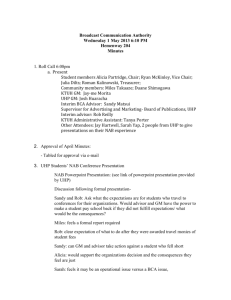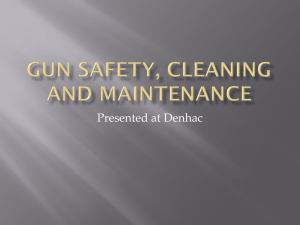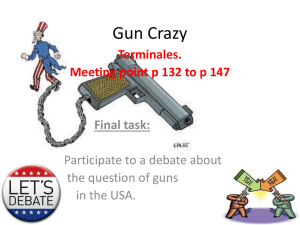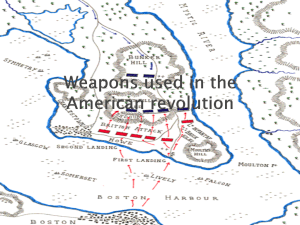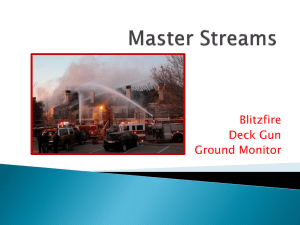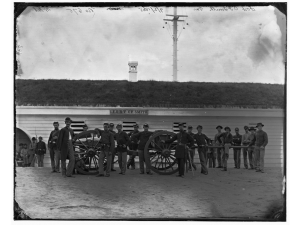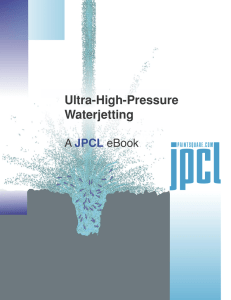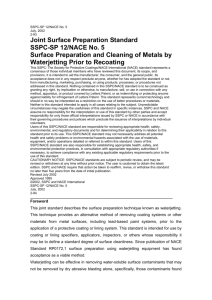Presentation_Slides
advertisement
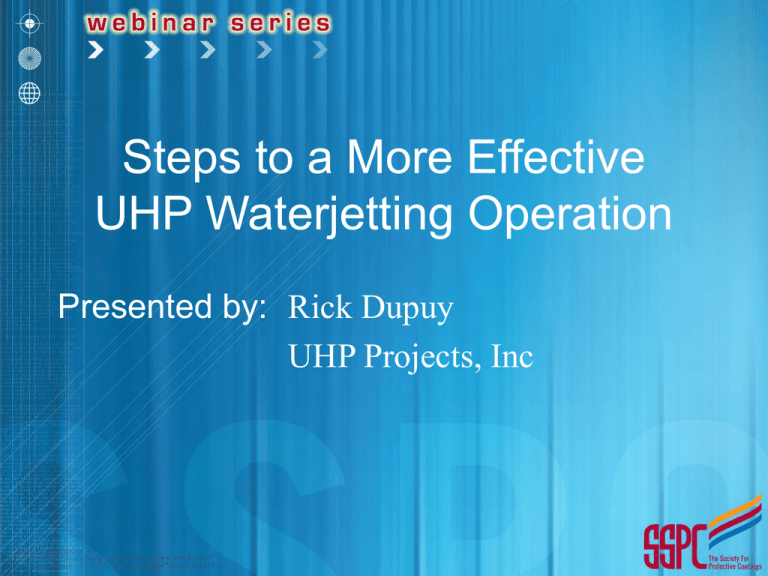
Steps to a More Effective UHP Waterjetting Operation Presented by: Rick Dupuy UHP Projects, Inc Learning Outcomes – Describe the purpose of surface preparation and what it includes – Using SSPC VIS 4/NACE VIS 7, determine the initial condition of a surface and assess the level of cleanliness – Using SSPC SP-WJ/NACE WJ standards to demonstrate ability to achieve the level of waterjet cleanliness required for a given job – Identify the components of the waterjetting system • 3 Viewpoints required for successful coatings application 1. Owner / Inspector 2. Contractor 3. Coatings Manufacturer • 3 Performance Criteria needed for successful coatings 1. Visual – SSPC standards 2. Profile – based on coatings manufacturer requirements for the coatings specified 3. Non-visible contaminants UHP Waterjetting Surface Preparation Processes • Pre-Cleaning • Cleaning • Post-Cleaning – before coating application Pre-Cleaning • Pre-cleaning may involve: – Removal of grease/oil, gross contaminants – May require the use of degreasers or other solvents and low pressure water cleaning – Repair of defects in steel Pre-cleaning - SSPC SP 1 Solvent Cleaning • Always performed first if necessary, regardless of which surface preparation method is selected • Requires removal of all visible oil, grease, drawing compounds, and other contaminants from steel prior to surface preparation Surface Imperfections May Need to be Corrected Prior to Surface Preparation • • • • • • • Sharp edges Weld spatter Burrs Pits Crevices Laminations Porosity SSPC PA Guide 11 • This guide discusses the technique called “stripe coating” or “striping” as a way of providing extra corrosion protection measures on edges, outside corners, crevices, bolt heads, welds, and other irregular steel surfaces, including optional surface preparation techniques for sharp edges to improve coating performance Surface Preparation • Actual surface preparation involves: – Preparing the surface to accept the coatings specified – Ensure that the surface is cleaned to the standard specified and for the coatings specified – Removing existing coatings, rust and other unwanted materials from the surface – Waterjetting surface to a stated visual cleanliness level Common Surface Preparation Methods and SSPC Standards – Degreasing (SP 1) – SP WJ-1 Clean to Bare Substrate – SP WJ-2 Very Thorough Cleaning – SP WJ-3 Thorough Cleaning – SP WJ-4 Light Cleaning Visual Guides for Cleaned Steel • • • • • SSPC VIS 1 (Dry Abrasive Blast Cleaning) SSPC VIS 3 (Hand and Power Tool Cleaning) SSPC VIS 4 (Waterjetting) SSPC VIS 5 (Wet Abrasive Blast Cleaning) NSRP Flash Rust Guide Post-Cleaning • Post-cleaning prior to coating application involves verifying that the surface is: – Dry – Still free of contaminants, including dust and dirt that could have accumulated since surface preparation – Still at the required cleanliness level – Ensure that the surface is an acceptable level of flashrust for the coatings specified Advantages of UHP Waterjetting • Used where profile is already established • Does a good job of reducing/eliminating surface contaminants • Used where solid particles will cause harm - controls unwanted emissions • Can reduce disposal costs particularly on hazardous coatings • Can minimize containment requirements • Can be used to remove coatings layer by layer • Less interference with other trades and activities • Removes elastomeric coatings effectively Pressures for Cleaning with Water • Low-pressure water cleaning (LP WC): less than 5,000 psi (34 MPa) • High-pressure water cleaning (HP WC): 5,000 to 10,000 psi (34 to 70 MPa) • High-pressure waterjetting (HP WJ): 10,000 to 30,000 psi (70 to 210 MPa) • Ultra High Pressure waterjetting (UHP WJ): above 30,000 psi (210 MPa) Top Coats Primer Substrate Types of UHP Tools • Manual Guns • Manually operated vacuum attached – Floor, Deck, Wall (“Lawnmower”) • Automated / Robotic How do You Decide Which Equipment to Use? • Size of project and project requirements • Project time constraints or productivity requirements • Knowledge level of personnel doing the work • Jobsite requirement for water collection • Full removal or partial removal of coatings • Hazardous coating removal and personnel/environmental protection Typical Equipment Setup for Manual Gun Operation Hand activated on/off – double trigger rotating nozzle Remote shutoff Correct Stance and Hose Placement Recommended PPE Standard PPE – Safety glasses, hard hats, Hearing protection, FRC Cut resistant gloves Metatarsal Boots Full Face Shields Heavy rain suits Task specific PPE – Safety harnesses, respirators, H2S monitors, etc. Cut Resistant Clothing is Becoming More Operator Friendly Automated / Robotic Equipment • Vacuum Recovery removes both coatings and effluent water from the nozzle (Keeps water from pooling on the surface) • Closed Loop (Water filtered and recirculated) • Open Loop (Water used once) Automated UHP Equipment Vacuum System Remote-Control System Horizontal Large Surface Robot Manually Operated Vacuum Attached Equipment Primary Components of the Waterjetting System • Pump – Positive Displacement or Intensifier • Pressure and volume are considerations • Type of power source • Gun – Dry shut off or Dump • Rotating or non-rotating • Hose • Vacuum system if required • Nozzle • Accessories Skid-Mounted UHP Pump Skid mounted UHP Pump Typical Single User Pump Pump with Vacuum Recovery Vacuum Systems • Sized to the flow and the application. – Venturi nozzle to drum – Skid mounted vacuum systems – Large vacuum truck • How is the effluent from the vacuum going to be handled • Multiple tools from same system • NEVER put your hand in front of the vacuum hose. Vacuum System •Vacuum equipment is often integrated into a skid package. This unit can be mounted on the back of a pickup truck with a 220 gallon tank 40-55,000 psi Hose Hoses and Connections • Burst rating should be a minimum of 2.5 times working pressure of the hose • Test high-pressure hoses at 1.5 times working pressure • Fittings should be rated for the working pressure • Inspect hoses for shroud abrasion, leaks, and flow restrictions (such as squashed fittings) before each use Hose Accessories: Bend Restrictors, Containment Grips (Whip Check) Proper UHP Hose Care • Never run hoses over sharp edges – use softeners and suspend hoses • On long vertical runs don’t let the hose connectors bear the full weight of the hoses • Don’t let vehicle traffic run over hoses • Store hoses in a protected location with ends connected • Always clean and lubricate ends before connecting Handheld UHP tools • Attached to the UHP pump by hose • Incorporates a control valve, guard, lance (barrel), usually a rotation device and nozzle • Comes in various lengths, normally with dual triggers. May also have a support handle and a shoulder stock • The control valve used to relieve the pressure further defines the gun type UHP waterjetting using handheld tools Traditional UHP waterjetting used handheld tools rotating nozzle hand activated on/off remote shutoff Handheld UHP tools Dump gun: – Moves pressure to the atmosphere, i.e. water continues to flow but at low pressure when the valve is released Dry shut-off gun: – Pressure is retained in the system with a shutoff control valve, i.e. you see no water at the gun, but it is re-circulated to the system Dump Gun • Dump gun: – Designed with a tube for depressurization (dump mode) at the nozzle – May be used alone or in a multi-gun operation with an adjustable constant pressure valve to ensure that pressure does not change abruptly – When the dump gun valve is closed, the gun is blasting with free passage of water through the nozzle – When the valve is released the water is “dumped” at the gun – The operator can modulate the pressure Dump Gun Dry Shut-Off Gun – Designed for use with a pressure regulator (or tumble box) for single or multi-gun applications – When the internal valve is open, water flows through the nozzle. When the operator closes the valve, there is no flow through the gun – The shut-off gun is either “on” or “off.” The operator cannot modulate the pressure at the trigger. This can slightly improve productivity – Pressure is relieved away from the operator – The tumble box is designed to maintain constant pressure in the hose and gun. Dry Shut-Off Gun Nozzles • • • • • • • Rotating Non-Rotating Self-rotating Fan or zero-degree Self-propelled or air-propelled Number of orifices and size Wear guards available UHP Nozzle Assemblies Nozzles are usually multiorifice configurations Use sapphire or diamond orifices for UHP WJ. UHP Waterjetting is a Proven Technology with Proven Benefits • • • • Write good specifications Choose an experienced UHP contractor Use the correct equipment for the project Follow good quality practices Questions?
